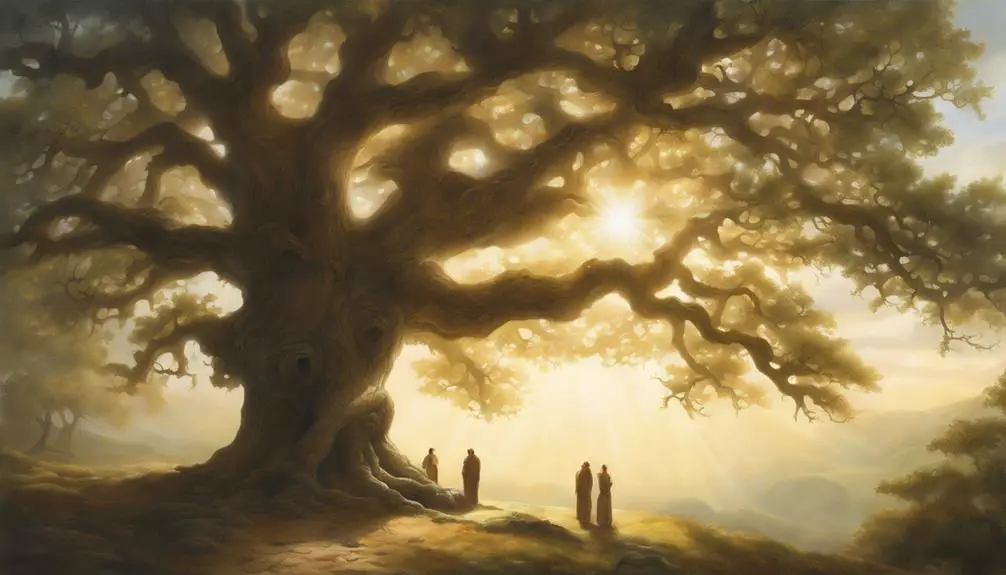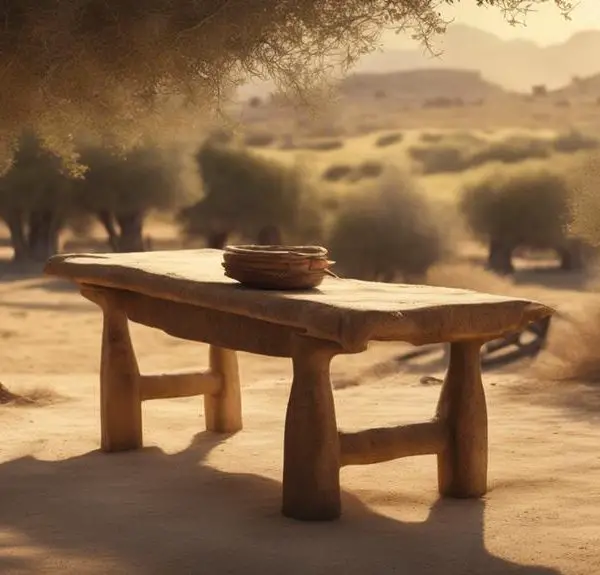Mystical and mighty, the oak tree in the Bible symbolizes strength and wisdom, inviting readers to explore its deep, enduring roots in scripture.

Meaning of Oak Tree in the Bible
In the vast universe of biblical symbolism, the oak tree stands as a colossus, straddling the ancient texts with its deep roots and towering presence. You'll find it whispering secrets of endurance and strength, offering shade for sacred meetings and divine encounters.
It's not just a backdrop for pivotal moments; the oak holds the keys to understanding wisdom, righteousness, and the profound legacy left by those who sought its shelter. As you explore its significance, you might just uncover how this enduring symbol weaves through the tapestry of biblical narratives, offering insights that resonate even today.
Why does the oak merit such reverence, and how does its symbolism enrich our understanding of the biblical text? Let's ponder this together.
Key Takeaways
- Oak trees symbolize strength, resilience, and the enduring nature of faith.
- They mark significant spiritual encounters and the forging of divine covenants.
- Represent the gradual development of wisdom and righteousness through adversity.
- Serve as timeless witnesses to divine promises and spiritual heritage.
Symbol of Endurance and Strength

Throughout the biblical narrative, the oak tree stands as a symbol of endurance and strength, embodying the resilience and steadfastness that are often called upon in times of trial. This isn't just a random choice. The ancient significance of the oak tree, deeply rooted in various cultures, lends an added layer of meaning to its biblical appearances. You'll find that in many ancient societies, the oak was revered for its size and longevity, qualities that made it a natural symbol of power and survival through adversity.
Cultural interpretations further enrich this symbolism. For instance, in some traditions, the oak is considered a sacred connection between the heavens and the earth, its towering presence seen as a bridge between the divine and the mortal. This dual significance of natural strength and spiritual connection underscores its appearances in biblical contexts, providing a multifaceted symbol that resonates with the themes of perseverance and faith.
Sacred Meetings and Encounters

In biblical narratives, oak trees often serve as the backdrop for significant encounters and sacred meetings, symbolizing a place where the divine and human realms intersect. This intertwining of nature and spirituality underscores the oak's profound spiritual symbolism, offering a rich tapestry of cultural interpretations that vary, yet converge on common themes:
- A locus for divine communication: Oak trees are often depicted as sites where prophets and leaders receive divine messages, emphasizing the tree's role as a bridge between worlds.
- A symbol of steadfast faith: Just as the oak stands firm, it mirrors the unwavering faith required to engage in spiritual dialogues.
- A sanctuary for reflection and prayer: The tranquil canopy of an oak provides a serene environment conducive to meditation and prayer.
- A witness to covenantal promises: Without delving into divine promises specifically, oaks are present during pivotal moments, suggesting their silent testimony to sacred agreements.
These elements highlight the oak's significance beyond mere flora, embedding it deeply within the spiritual and cultural fabric of biblical stories. It's not just about the physical presence of these trees, but what they represent at the crossroads of human and divine interaction.
Sites of Divine Promises

Delving into the realm of divine promises, oak trees emerge as pivotal symbols where covenants between the divine and humanity are often forged and witnessed. These majestic trees aren't just passive spectators but active participants in the biblical narrative, marking the sites where foundational covenants were established. Their robust presence underscores the gravity and permanence of these divine promises.
In the context of angel appearances, oak trees serve as the backdrop for celestial messengers delivering God's covenantal promises. These instances aren't mere coincidences but deliberate choices, highlighting the oak's symbolic role as a witness to divine intervention. The appearance of angels under these trees underscores the sacredness of the message and the location, reinforcing the tree's significance in the divine-human dialogue.
Furthermore, the origins of covenants often find their roots in the shade of oak trees. These sites become hallowed ground, where the boundaries between heaven and earth blur, allowing for a direct communication channel with the divine. The oak stands as a testament to these moments, embodying the steadfastness and resilience of the promises made beneath its boughs. This connection between oak trees and covenant origins offers a profound insight into the symbiotic relationship between nature and the divine, illustrating how the natural world participates in the spiritual economy of the biblical narrative.
Wisdom and Righteousness

Moving beyond their role as markers of divine promises, oak trees also embody themes of wisdom and righteousness within the biblical narrative. These sturdy trees, with their deep roots and expansive canopies, serve as a metaphor for the steadfast and righteous character that's highly valued in biblical texts. In exploring Solomon's teachings and the Proverbs insights, one can't help but notice the parallel between the characteristics of the oak and the virtues of wisdom and righteousness.
Consider the following aspects where oak trees symbolize wisdom and righteousness:
- Endurance: Just like the oak stands firm against storms, wisdom provides the strength to endure life's challenges.
- Growth: As an oak tree grows slowly but surely, wisdom and righteousness develop gradually over a lifetime.
- Shelter: The oak offers shelter to all who seek it; similarly, wisdom and righteousness provide a refuge for the soul.
- Legacy: The longevity of the oak mirrors the lasting impact of wisdom on future generations.
These analogies highlight how the biblical narrative interweaves natural imagery with moral and spiritual lessons, encouraging readers to seek wisdom and live righteously. Solomon's teachings and the insights from Proverbs thus find a vivid representation in the enduring, righteous oak.
Legacy and Memorial Significance

Oak trees, through their enduring presence, offer a profound illustration of legacy and memorial significance within biblical texts, serving as timeless markers of spiritual heritage and divine encounters. These majestic trees aren't just physical entities; they're imbued with layers of meaning, representing the deep connections to family roots and ancestral heritage that the Bible often explores. As you delve into the stories and passages, it's clear that oak trees stand as living memorials, echoing the faith and resilience of past generations.
Aspect |
Significance |
Biblical Reference |
|---|---|---|
Strength |
Symbolizes the enduring nature of faith |
"Oaks of righteousness" (Isaiah 61:3) |
Longevity |
Reflects the lasting legacy of spiritual teachings |
Abraham's oak in Mamre (Genesis 13:18) |
Witness |
Acts as silent observers to divine covenants |
Jacob's pillar under an oak (Genesis 35:4) |
Renewal |
Embodies hope and renewal of the covenant with God |
Renewal at Shechem (Joshua 24:26) |
In this context, oak trees aren't merely part of the landscape. They're dynamic symbols, connecting the dots between the divine, the land, and its people. This intricate tapestry of relations highlights the importance of understanding and preserving ancestral heritage, a theme that resonates deeply within the biblical narrative.
Frequently Asked Questions
How Does the Oak Tree's Seasonal Changes Relate to Christian Beliefs and Practices?
You're exploring how an oak tree's seasonal changes intertwine with Christian beliefs and practices, focusing on seasonal metaphors and Christian symbolism.
In spring, the oak's rebirth mirrors resurrection themes, symbolizing new beginnings and hope.
Summer's full foliage represents spiritual maturity and abundance.
Autumn, with its shedding leaves, reflects themes of sacrifice and letting go, while winter's bareness emphasizes a period of waiting and reflection, akin to Advent.
These cycles offer profound insights into Christian teachings.
Can the Oak Tree Be Linked to Any Specific Parables or Teachings of Jesus in the New Testament?
You're exploring whether oak symbolism or tree metaphors from Jesus' teachings resonate with the New Testament.
While not directly linked to specific parables, the enduring nature of oaks can reflect Christian tenets of strength and faithfulness.
Analyzing biblical texts, one finds that although Jesus often employed nature in his lessons, direct references to oaks are scarce.
However, the broader context of trees in scriptural metaphors enriches our understanding of spiritual growth and resilience.
Are There Any Lesser-Known Biblical Characters or Stories Associated With Oak Trees Not Tied to the Main Themes Mentioned?
You'll find oak symbolism woven subtly into lesser-known narratives, like Deborah's story. This isn't just a backdrop; it's pivotal, marking a place of leadership and judgment.
Deborah, a prophetess, held court under a palm tree, but her story intersects with oak trees symbolizing strength and endurance.
Analyzing such instances sheds light on the nuanced layers of biblical text, where even the flora carries weight in shaping the narrative's context.
How Do Different Translations of the Bible Handle References to Oak Trees, and Does This Affect Their Symbolic Meaning?
You'll find that translation consistency and cultural interpretations play crucial roles in how different versions of the Bible handle references to oak trees. Analyzing these variations can reveal shifts in symbolic meaning, as translators' choices reflect their cultural and theological backgrounds.
This scholarly exploration highlights the complexity of biblical texts, showing how understanding shifts with language and context, and underscores the importance of examining translation practices to grasp the full spectrum of symbolism in religious texts.
In Biblical Archaeology, Have There Been Any Significant Findings Related to Oak Trees That Provide Historical Context to Their Importance in Biblical Times?
In biblical archaeology, significant findings linked to oak trees have indeed illuminated their role in ancient societies. Discoveries showcasing ancient carpentry tools and constructions reveal how these trees weren't only ecologically significant but also vital for building and daily life.
Such evidence provides a deeper understanding of their importance, beyond their symbolic interpretations, highlighting the tangible contributions of oak trees to the sustainability and development of communities in biblical times.
Conclusion
In conclusion, the oak tree's symbolism in the Bible spans endurance, sacred encounters, divine promises, wisdom, and legacy. Its robust presence, often living over 200 years, mirrors the spiritual resilience and steadfastness celebrated in biblical narratives.
Interestingly, one study found that areas with ancient oak trees have higher biodiversity, highlighting the tree's role in sustaining life, much like its biblical representation of supporting spiritual growth and community. This multifaceted symbol enriches our understanding of biblical themes, offering a profound connection between nature and spirituality.



Sign up